Christmas / Cripple Labels Tied / Untied
Quote from Steve on June 8, 2024, 11:38 amSouth Africa Christmas Labels & Easter Cripples Labels are commonly seen when one is out hunting for philatelic items. As their names suggest they were issued at different times of the year to coincide with the Christian festivals of Christmas and Easter. They term 'Cripple' is no longer used to describe a disabled person. The design of both sets of labels varies from year to year.
These privately printed labels are stuck on envelopes for the purpose of creating awareness of and to raising funds to fight Tuberculosis (TB) among children. The first South African Christmas Labels were introduced in 1929 and continued to be issued annually up until 1993. As their name suggests, they were sold in the run-up to Christmas, a charitable time of year.
From 1932 the labels were printed by the Government printer who often used the same watermarked paper as found in postage and revenue stamps. The first booklets were issued in 1934. These came in two varieties, a booklet of one pane and six labels making a face value of 6d and a booklet with two panes of six labels making a face value of one shilling. As with postage stamps, collectable varieties, sheets, booklet panes and tete-beche blocks can be found.
While this post starts with labels on cover, I would hope someone will post a complete selection of Christmas labels from 1929 to 1993. Regarding postal history of covers, thehere are two main groups of Christmas Labels on cover. those where the label stands alone and those that are tied to covers by the cancellation or franking of the envelope. When a label is tied to a cover by part of a postmark it confirms that this is genuine, original use of the Christmas label.
The problem with an untied label is that it could have and often is placed on previously posted covers to enhance their attarctiveness and value. A dealer I know who has done this seems to think there is nothing wrong with a little "historical embellishment". I disagree. It is fraud. He is enhancing a cover he previously could not sell by making it appear to be something it is not. As a result, tied lables on cover are more valuable and collectable. Nevertheless, untied labels do have a pleasing ability to enhance a covere - and many of them, perhaps most, - are quite legitimate.
Here are two attractive covers where the Christmas label in not tied to the cover ie. examples like this may not be genuine.
Cover from ZASTRON '27 NOV 42' to Burmeister & Co., East London. Unilingual Afrikaans Christmas ('Kersmis') label of 1942. The date of posting fits this label. It is probably genuine use.
Cover from WALVIS BAY '14 XII 63' to WINDHOEK. Bilingual Christmas / Kersfees label of 1963. The date of posting fits this label. It is probably genuine use.
Here are three covers where the Christmas label is tied to the cover ie. they are genuine. These are more collectable and valuable than the above untied examples. However, what you collect - and why! - is really just a matter of personal taste. Personally, I think a mix of both tied and untied examples on cover makes for a perfectly good and interesting Christmas Label / Easter Cripple display.
Cover from JOHANNESBURG '1 XII 39' to GB. Bilingual pair of Christmas ('Kersmis') labels of 1938. The bearing of a tied pair of Christmas labels adds to the value and interest of this cover.
Cover from BLOEMFONTEIN '14 XII 48' to GERMANY. The "A NEW LIFE FOR CRIPPLED CHILDREN" label top right is tied. The unilingual Afrikaans Christmas Kersfees label of 1948 bottom left is untied. The date of posting fits this label. Why would you embellish a cover that already had a label on it? This is probably genuine use on what appears to be an attempt at a philatelic cover.
Cover from CRADOCK '1964 20 III' to Burmeister & Co., East London. Unilingual Afrikaans Easter ('PAAS') "HELP CRIPPLES' (Kreupeles) label of 1964. Note that this is an Easter, not Christmas label. The date of posting fits this label. There is nothing fancy about this attractive cover. It shows everyday use of both a postage stamp and a charity label.
South Africa Christmas Labels & Easter Cripples Labels are commonly seen when one is out hunting for philatelic items. As their names suggest they were issued at different times of the year to coincide with the Christian festivals of Christmas and Easter. They term 'Cripple' is no longer used to describe a disabled person. The design of both sets of labels varies from year to year.
These privately printed labels are stuck on envelopes for the purpose of creating awareness of and to raising funds to fight Tuberculosis (TB) among children. The first South African Christmas Labels were introduced in 1929 and continued to be issued annually up until 1993. As their name suggests, they were sold in the run-up to Christmas, a charitable time of year.
From 1932 the labels were printed by the Government printer who often used the same watermarked paper as found in postage and revenue stamps. The first booklets were issued in 1934. These came in two varieties, a booklet of one pane and six labels making a face value of 6d and a booklet with two panes of six labels making a face value of one shilling. As with postage stamps, collectable varieties, sheets, booklet panes and tete-beche blocks can be found.
While this post starts with labels on cover, I would hope someone will post a complete selection of Christmas labels from 1929 to 1993. Regarding postal history of covers, thehere are two main groups of Christmas Labels on cover. those where the label stands alone and those that are tied to covers by the cancellation or franking of the envelope. When a label is tied to a cover by part of a postmark it confirms that this is genuine, original use of the Christmas label.
The problem with an untied label is that it could have and often is placed on previously posted covers to enhance their attarctiveness and value. A dealer I know who has done this seems to think there is nothing wrong with a little "historical embellishment". I disagree. It is fraud. He is enhancing a cover he previously could not sell by making it appear to be something it is not. As a result, tied lables on cover are more valuable and collectable. Nevertheless, untied labels do have a pleasing ability to enhance a covere - and many of them, perhaps most, - are quite legitimate.
Here are two attractive covers where the Christmas label in not tied to the cover ie. examples like this may not be genuine.
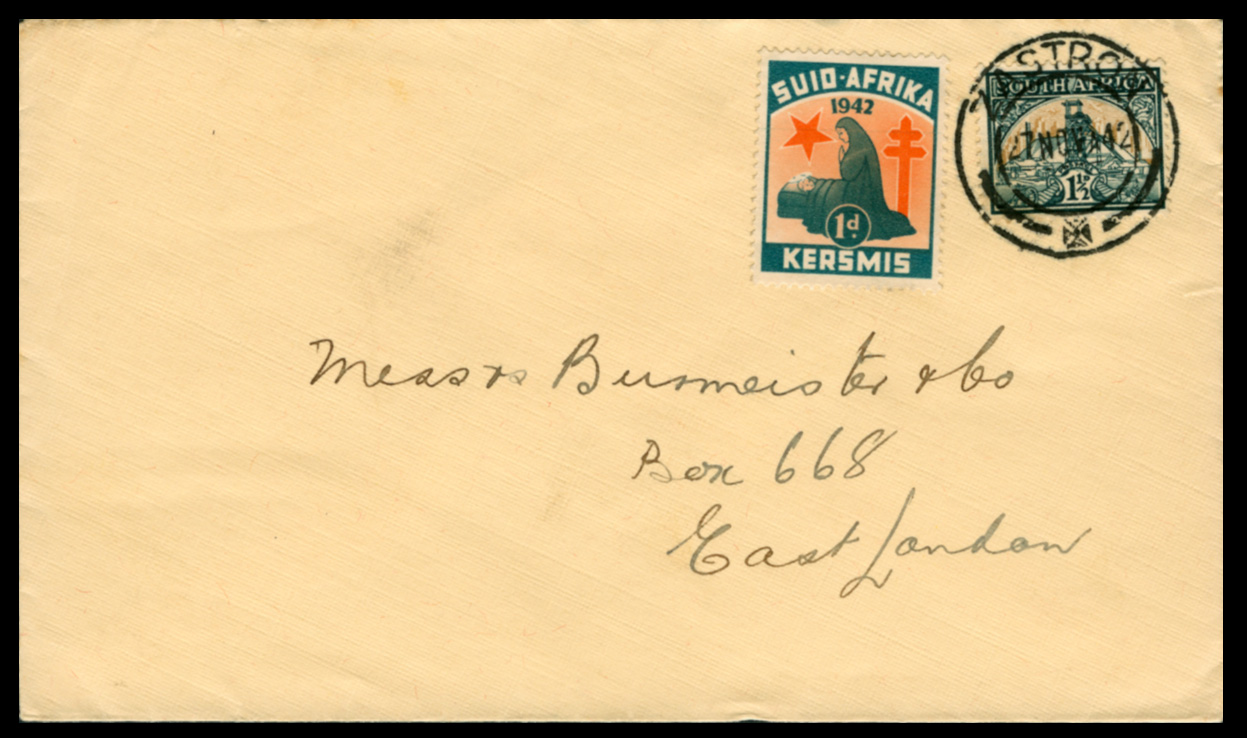
Cover from ZASTRON '27 NOV 42' to Burmeister & Co., East London. Unilingual Afrikaans Christmas ('Kersmis') label of 1942. The date of posting fits this label. It is probably genuine use.
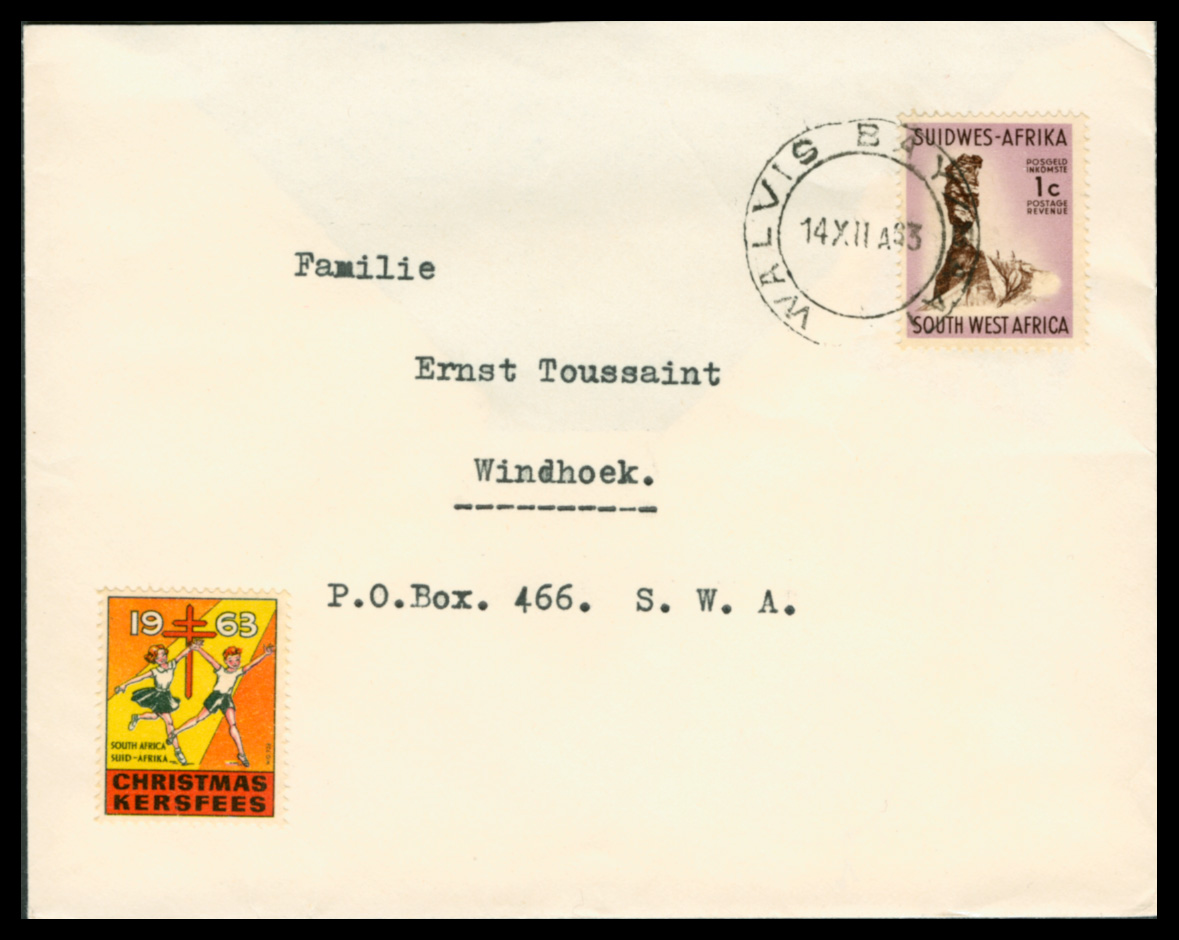
Cover from WALVIS BAY '14 XII 63' to WINDHOEK. Bilingual Christmas / Kersfees label of 1963. The date of posting fits this label. It is probably genuine use.
Here are three covers where the Christmas label is tied to the cover ie. they are genuine. These are more collectable and valuable than the above untied examples. However, what you collect - and why! - is really just a matter of personal taste. Personally, I think a mix of both tied and untied examples on cover makes for a perfectly good and interesting Christmas Label / Easter Cripple display.
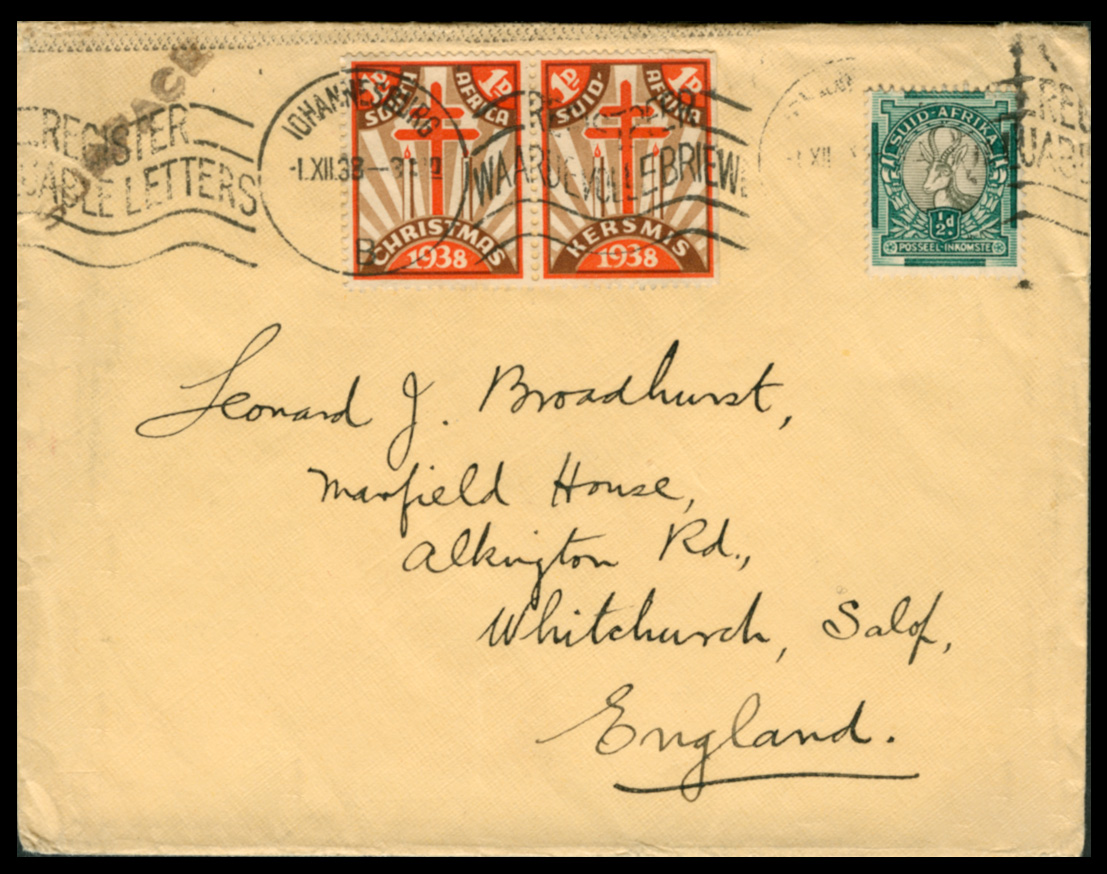
Cover from JOHANNESBURG '1 XII 39' to GB. Bilingual pair of Christmas ('Kersmis') labels of 1938. The bearing of a tied pair of Christmas labels adds to the value and interest of this cover.
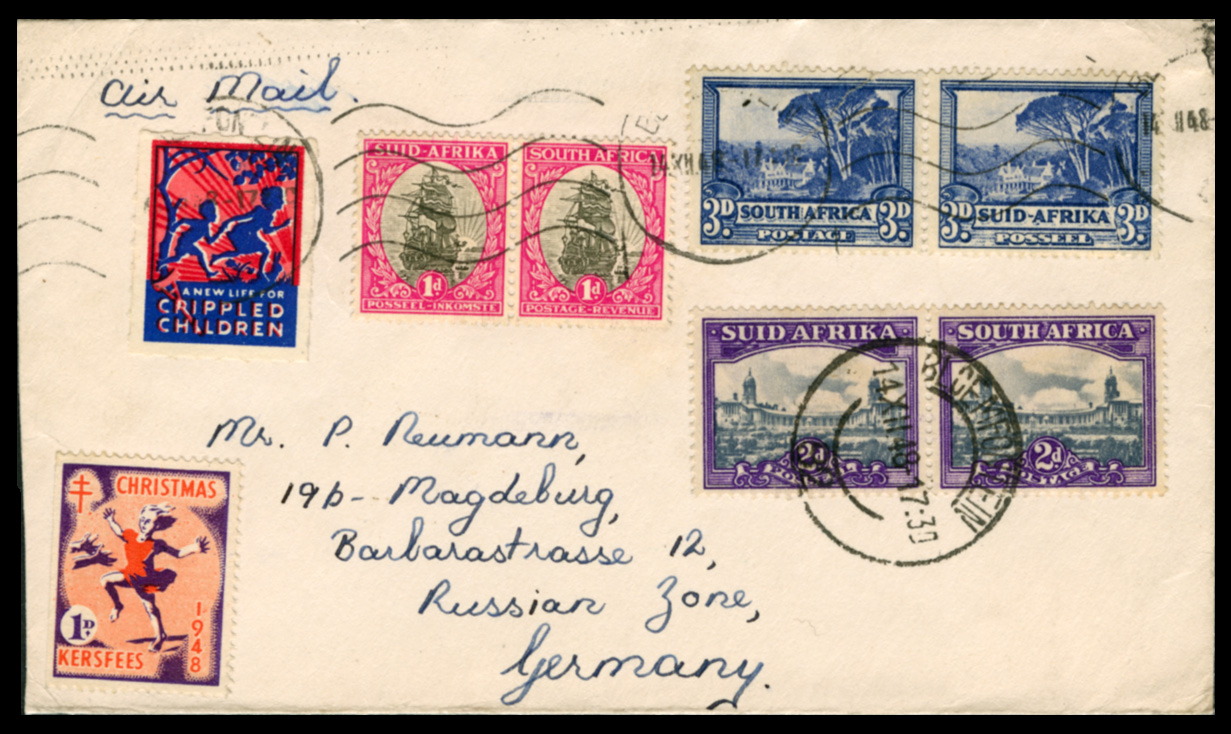
Cover from BLOEMFONTEIN '14 XII 48' to GERMANY. The "A NEW LIFE FOR CRIPPLED CHILDREN" label top right is tied. The unilingual Afrikaans Christmas Kersfees label of 1948 bottom left is untied. The date of posting fits this label. Why would you embellish a cover that already had a label on it? This is probably genuine use on what appears to be an attempt at a philatelic cover.
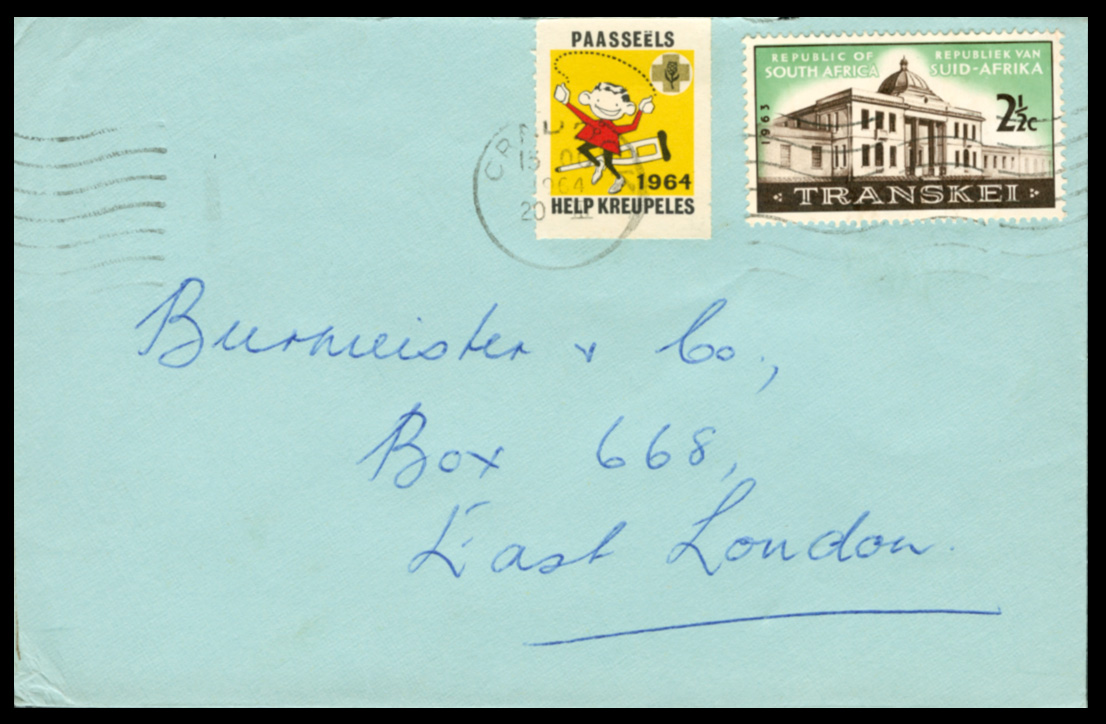
Cover from CRADOCK '1964 20 III' to Burmeister & Co., East London. Unilingual Afrikaans Easter ('PAAS') "HELP CRIPPLES' (Kreupeles) label of 1964. Note that this is an Easter, not Christmas label. The date of posting fits this label. There is nothing fancy about this attractive cover. It shows everyday use of both a postage stamp and a charity label.
